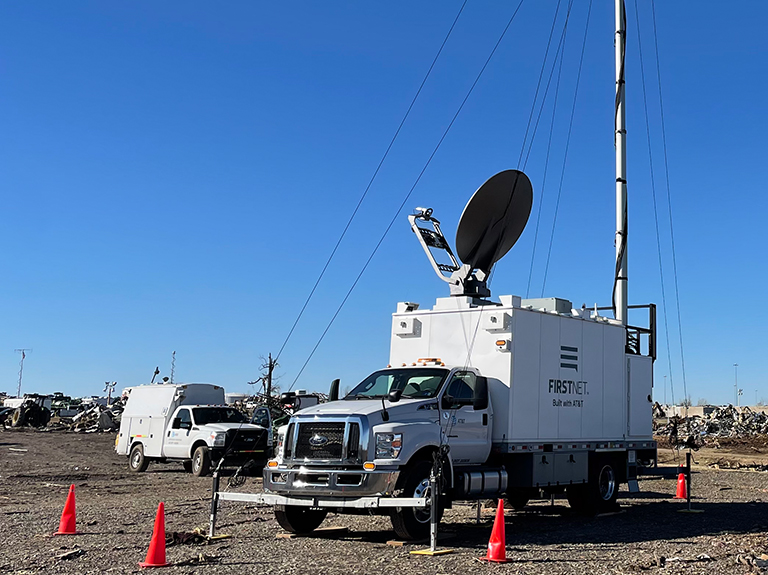It’s not an overstatement to say that everything has changed the past few months. And things will probably continue to change. The simple act of going to the grocery store is not so simple anymore, and Americans are settling for take-out instead of a relaxing Friday night at our favorite restaurants. Most of these changes are manageable, even if a little inconvenient. But what happens when people need a doctor while sheltering in place? During this pandemic, Americans are being urged to avoid the doctor’s office and hospitals. Telehealth is where technology and healthcare converge to provide routine and lifesaving care.
The federal government and healthcare industry have been working to expand coverage and improve access to telehealth services. This means more at-risk patients can be treated in place without leaving the comfort and safety of their home. FirstNet® – the only nationwide, high-speed broadband communications platform dedicated to and purpose-built for America’s first responders and the extended public safety community – is providing the connectivity healthcare providers need to deliver premium care, even if the doctor isn’t there in person. It’s just one of the reasons why we’re supporting the nation’s nurses and physicians with three months of free service on the FirstNet network.1
To further support telehealth, AT&T is providing the connectivity for VitalTech, who is offering 60 days of free telehealth services through the VitalCare® platform to business customers like hospitals to support their physicians and their patients. And we’re working with Centene, a leading multi-national healthcare company, to streamline access to FirstNet for its primary care providers and expand telehealth options in rural communities. Because reaching rural and remote parts of America is one of our top priorities. That’s why last year alone we added 120,000+ square miles of LTE coverage area to the FirstNet network. This means more communities – rural, urban and tribal – are gaining access to unique services like telehealth. By increasing access to physicians and specialists, telehealth helps ensure patients receive the right care, at the right place, at the right time.
And unlike commercial offerings, FirstNet provides real, dedicated mobile broadband when needed with always-on priority, as well as preemption for first responders. Prioritization means data-intensive applications on FirstNet – like telehealth – can more reliably perform than when on a commercial network. It’s just one of the ways FirstNet is helping support the evolution of telehealth and reliably extend its reach to physicians, field-based first responders and their patients.
The First Responder Network Authority’s (FirstNet Authority) Public Safety Advisory Committee also had a team of members from EMS-focused national public safety associations dedicated to exploring new applications of telehealth to help deal with situations just like this. The FirstNet network – built in public-private partnership with the FirstNet Authority – was designed with substantial and continuous input from public safety to guarantee that the needs of today and tomorrow are met. And we’re dedicated to reacting quickly and efficiently, delivering the capabilities that our public safety and healthcare systems need to do their job effectively and efficiently.
FirstNet can be used daily by first responders for emergency medical services, and in turn help maintain a semblance of normalcy for patients across the country through telehealth services. Doctors and nurses can video chat with their patients, as well as send video, medical imaging and medical vital sign information to people within the medical network that need them. And because FirstNet routes all first responders’ information through a dedicated network core, it’s built with enhanced security (like end-to-end data encryption) and reliability – ideal for when sending medical and patient information.
By making it easier for doctors to remotely connect with patients, we’re doing what we can to help keep Americans safer and healthier. Because non-COVID healthcare is still just as important as it was before the outbreak, and we must do what we can to keep it running smoothly – while we continue to combat the spread of COVID-19.
To learn more about the FirstNet network, go to FirstNet.com.
1 Ltd. time offer. Credits equal to 3 months of recurring service charges (incl taxes & fees) on a FirstNet Mobile--Responder plan for smartphone or tablet will start within 3 bills. Available only to eligible physicians and nurses who have, or qualify and subscribe to a new, FirstNet Mobile--Responder plan. For current subscribers, credits will automatically be applied to an existing line of service. New subscribers may migrate an AT&T line of service or activate a new FirstNet Mobile—Responder line of service. New subscribers must qualify for FirstNet service and complete verification process within 30 days. Customer must provide or purchase their own device and use a FirstNet SIM. See below for complete details.


